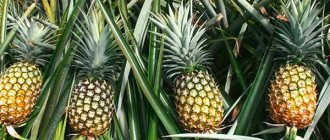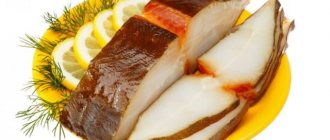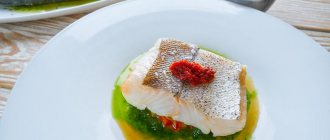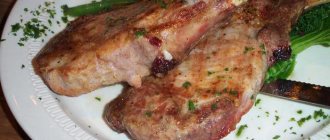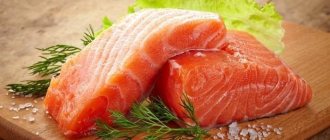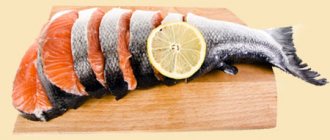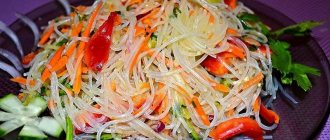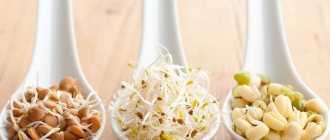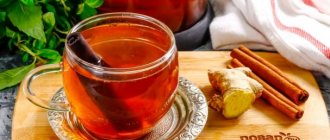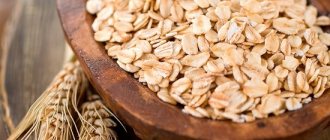Calorie content, composition, nutritional value
The energy value of Atlantic salmon depends on the method of processing the meat. Initially, the calorie content of a raw piece of salmon in 100 g is 140 kcal.
During cooking, this indicator changes as follows:
- in baked fish - 185.6 kcal;
- boiled - 180 kcal;
- steamed - 176.7 kcal;
- fried - 256.7 kcal;
- in salted food - 205.4 kcal;
- smoked - 202.5 kcal.
The chemical composition of salmon includes vitamins A, PP, B1, B2, C, E, D, as well as useful minerals: potassium, calcium, magnesium, iron, phosphorus and zinc.
Salmon is also distinguished by its high content of omega-3 fatty acids and iodine, which contribute to the proper functioning of all organs, strengthening the immune system and maintaining good health.
The nutritional value of salmon is characterized by the complete absence of carbohydrates in its composition.
Nutritional value and chemical composition of “Salmon”.
The table shows the nutritional content (calories, proteins, fats, carbohydrates, vitamins and minerals) per 100 grams of edible portion.
| Nutrient | Quantity | Norm** | % of the norm in 100 g | % of the norm in 100 kcal | 100% normal |
| Calorie content | 174 kcal | 1684 kcal | 10.3% | 5.9% | 968 g |
| Squirrels | 21 g | 76 g | 27.6% | 15.9% | 362 g |
| Fats | 10 g | 56 g | 17.9% | 10.3% | 560 g |
| Water | 64.89 g | 2273 g | 2.9% | 1.7% | 3503 g |
| Ash | 1.13 g | ~ | |||
| Vitamins | |||||
| Vitamin A, RE | 40 mcg | 900 mcg | 4.4% | 2.5% | 2250 g |
| Vitamin B1, thiamine | 0.23 mg | 1.5 mg | 15.3% | 8.8% | 652 g |
| Vitamin B2, riboflavin | 0.25 mg | 1.8 mg | 13.9% | 8% | 720 g |
| Vitamin B4, choline | 78.5 mg | 500 mg | 15.7% | 9% | 637 g |
| Vitamin B5, pantothenic | 1.6 mg | 5 mg | 32% | 18.4% | 313 g |
| Vitamin B6, pyridoxine | 0.8 mg | 2 mg | 40% | 23% | 250 g |
| Vitamin B9, folates | 26 mcg | 400 mcg | 6.5% | 3.7% | 1538 g |
| Vitamin B12, cobalamin | 3.23 mcg | 3 mcg | 107.7% | 61.9% | 93 g |
| Vitamin C, ascorbic acid | 3.9 mg | 90 mg | 4.3% | 2.5% | 2308 g |
| Vitamin D, calciferol | 8 mcg | 10 mcg | 80% | 46% | 125 g |
| Vitamin E, alpha tocopherol, TE | 3.55 mg | 15 mg | 23.7% | 13.6% | 423 g |
| beta tocopherol | 0.01 mg | ~ | |||
| gamma tocopherol | 0.3 mg | ~ | |||
| delta tocopherol | 0.05 mg | ~ | |||
| Vitamin K, phylloquinone | 0.5 mcg | 120 mcg | 0.4% | 0.2% | 24000 g |
| Vitamin RR, NE | 9.4 mg | 20 mg | 47% | 27% | 213 g |
| Betaine | 3 mg | ~ | |||
| Macronutrients | |||||
| Potassium, K | 420 mg | 2500 mg | 16.8% | 9.7% | 595 g |
| Calcium, Ca | 15 mg | 1000 mg | 1.5% | 0.9% | 6667 g |
| Magnesium, Mg | 27 mg | 400 mg | 6.8% | 3.9% | 1481 g |
| Sodium, Na | 59 mg | 1300 mg | 4.5% | 2.6% | 2203 g |
| Phosphorus, P | 240 mg | 800 mg | 30% | 17.2% | 333 g |
| Microelements | |||||
| Iron, Fe | 0.8 mg | 18 mg | 4.4% | 2.5% | 2250 g |
| Yod, I | 50 mcg | 150 mcg | 33.3% | 19.1% | 300 g |
| Cobalt, Co | 20 mcg | 10 mcg | 200% | 114.9% | 50 g |
| Manganese, Mn | 0.016 mg | 2 mg | 0.8% | 0.5% | 12500 g |
| Copper, Cu | 250 mcg | 1000 mcg | 25% | 14.4% | 400 g |
| Molybdenum, Mo | 4 mcg | 70 mcg | 5.7% | 3.3% | 1750 g |
| Selenium, Se | 24 mcg | 55 mcg | 43.6% | 25.1% | 229 g |
| Fluorine, F | 430 mcg | 4000 mcg | 10.8% | 6.2% | 930 g |
| Chromium, Cr | 55 mcg | 50 mcg | 110% | 63.2% | 91 g |
| Zinc, Zn | 0.64 mg | 12 mg | 5.3% | 3% | 1875 |
| Essential amino acids | |||||
| Arginine* | 1.221 g | ~ | |||
| Valin | 1.107 g | ~ | |||
| Histidine* | 0.549 g | ~ | |||
| Isoleucine | 0.968 g | ~ | |||
| Leucine | 1.615 g | ~ | |||
| Lysine | 1.87 g | ~ | |||
| Methionine | 0.626 g | ~ | |||
| Threonine | 0.86 g | ~ | |||
| Tryptophan | 0.209 g | ~ | |||
| Phenylalanine | 0.845 g | ~ | |||
| Nonessential amino acids | |||||
| Alanin | 1.271 g | ~ | |||
| Aspartic acid | 2.025 g | ~ | |||
| Hydroxyproline | 0.042 g | ~ | |||
| Glycine | 0.96 g | ~ | |||
| Glutamic acid | 2.83 g | ~ | |||
| Proline | 0.721 g | ~ | |||
| Serin | 0.896 g | ~ | |||
| Tyrosine | 0.759 g | ~ | |||
| Cysteine | 0.219 g | ~ | |||
| Sterols (sterols) | |||||
| Cholesterol | 55 mg | max 300 mg | |||
| Saturated fatty acids | |||||
| Saturated fatty acids | 3.05 g | max 18.7 g | |||
| 14:0 Miristinovaya | 0.556 g | ~ | |||
| 15:0 Pentadecane | 0.046 g | ~ | |||
| 16:0 Palmitinaya | 1.877 g | ~ | |||
| 17:0 Margarine | 0.043 g | ~ | |||
| 18:0 Stearic | 0.495 g | ~ | |||
| 20:0 Arakhinovaya | 0.022 g | ~ | |||
| 22:0 Begenovaya | 0.011 g | ~ | |||
| Monounsaturated fatty acids | 3.77 g | min 16.8 g | 22.4% | 12.9% | |
| 16:1 Palmitoleic | 0.791 g | ~ | |||
| 18:1 Oleic (omega-9) | 2.715 g | ~ | |||
| 20:1 Gadoleic (omega-9) | 0.265 g | ~ | |||
| Polyunsaturated fatty acids | 3.886 g | from 11.2 to 20.6 g | 34.7% | 19.9% | |
| 18:2 Linolevaya | 0.9 g | ~ | |||
| 18:3 Linolenic | 0.167 g | ~ | |||
| 18:3 Omega-3, alpha-linolenic | 0.148 g | ~ | |||
| 18:3 Omega-6, gamma-linolenic | 0.02 g | ~ | |||
| 18:4 Steoride Omega-3 | 0.121 g | ~ | |||
| 20:2 Eicosadiene, Omega-6, cis, cis | 0.062 g | ~ | |||
| 20:3 Eicosatriene | 0.018 g | ~ | |||
| 20:4 Arachidonic | 0.092 g | ~ | |||
| 20:5 Eicosapentaenoic acid (EPA), Omega-3 | 0.862 g | ~ | |||
| Omega-3 fatty acids | 2.507 g | from 0.9 to 3.7 g | 100% | 57.5% | |
| 22:5 Docosapentaenoic acid (DPA), Omega-3 | 0.393 g | ~ | |||
| 22:6 Docosahexaenoic acid (DHA), Omega-3 | 1.104 g | ~ | |||
| Omega-6 fatty acids | 1.074 g | from 4.7 to 16.8 g | 22.9% | 13.2% |
The energy value of Salmon is 174 kcal.
Primary Source: Created in the application by the user. Read more.
** This table shows the average levels of vitamins and minerals for an adult. If you want to know the norms taking into account your gender, age and other factors, then use the “My Healthy Diet” application.
Appearance of salmon
Salmon belongs to the salmon family, the ray-finned class. This is one of the largest representatives of its genus. Under natural conditions, it grows up to 1.5 m in length and can reach a weight of 40-45 kg. Such fish live up to 10-15 years.
Freshwater salmon are smaller in size and smaller in body weight. Adults can reach 15 kg with sufficient food in the reservoir.
What does salmon look like?
This fish has a number of common characteristics characteristic of the salmon family. The body of an adult is elongated and slightly flattened laterally. The skin is covered with silvery small scales that peel off easily.
The pectoral fins of Atlantic salmon are located below the midline. A special feature of representatives of this family is the presence of a small fin, which is located near the anus.
All over the salmon's body there are small dark spots that form the shape of the letter X.
The lower jaw of an adult protrudes forward and looks like a hook, and the upper jaw has a characteristic depression.
The age of a fish can be determined by the color of its scales. The body of young salmon is darker and has transverse spots. An adult has light scales on its back and an almost white belly. The body of a female preparing for spawning has a bronze tint with red spots.
Salmon fillet for your table.
How to distinguish salmon from trout by appearance
The difference between salmon and trout is primarily in size. The latter cannot grow more than 30 cm, and the maximum weight of this fish reaches only 2 kg. On her body there is a characteristic soft pink stripe with a pearlescent tint, which runs along the midline from head to tail.
When purchasing fillets of these salmon representatives, you can distinguish them by the color of their flesh. In trout it is bright pink, almost red. Salmon has a paler shade of pink, closer to orange.
Heat treatment also helps to accurately determine the name of the fish. The color of the salmon fillet practically does not change during the cooking process, but the trout becomes lighter, the shade of the flesh loses its richness.
Calorie content of fried salmon per 100 grams
Calorie content of fried salmon per 100 grams is 200 kcal. In 100 g of this fish:
- 18.1 g protein;
- 10.8 g fat;
- 7.3 g carbohydrates.
Read: Calorie content of coffee with cream and sugar
Recipe for fried salmon:
- 1 kg salmon fillet, cut into pieces of the required size;
- 3 chicken eggs mixed with 2 g of salt and 1 cup of flour;
- the fish is rolled in the resulting egg mixture and fried in a frying pan with vegetable oil.
How to choose salmon
When purchasing a whole carcass, you need to pay attention to the color of the gills: they should be pink, like the salmon flesh. A dark shade indicates the considerable age of the fish, and too bright a shade indicates the presence of artificial dyes. The pale hue and loose structure indicate that the fish has been frozen several times.
When choosing salted or smoked salmon, the production time of the product and the quality of packaging are important. The vacuum bag should be tight, with good air pumping. If the fish fillet returns to its original volume after pressing the flesh with your finger, it means that fresh fish was used to prepare the product.
Calorie content of smoked salmon per 100 grams
Calorie content of smoked salmon per 100 grams is 203 kcal. In 100 g of fish:
- 22.6 g protein;
- 12.4 g fat;
- 0 g carbohydrates.
Despite the fact that smoked salmon contains a lot of fatty acids, chlorine, nickel, fluorine, molybdenum, potassium, calcium, magnesium, iron, chromium, vitamins A, PP, this product is not recommended to be eaten in large quantities and often. Otherwise, malfunctions in the gastrointestinal tract, exacerbation of diseases of the liver, kidneys, pancreas, and the appearance of swelling cannot be ruled out.
How to store salmon
If Atlantic salmon is purchased for future use, it should only be stored in the refrigerator or freezer. Chilled fish should be placed in a bowl with crushed ice. This will help the salmon flesh stay juicy.
Smoked and salted Atlantic salmon in vacuum bags and plastic containers should be stored in the refrigerator without disturbing the integrity of the packaging and opening it only before eating the fish.
In the refrigerator, it is better to keep salmon wrapped in foil, away from other foods.
Salmon steaks should be stored in the refrigerator.
Calorie content of steamed salmon per 100 grams
Calorie content of steamed salmon per 100 grams is 195 kcal. In 100 g of product:
- 19.1 g protein;
- 14.1 g fat;
- 0 g carbohydrates.
Read: Calorie content of coconut per 100 grams
Thanks to steam treatment, salmon retains almost all its beneficial substances. Such fish contains a lot of Omega 3 and Omega 6 fatty acids, vitamins B, A, C, E, minerals potassium, calcium, fluorine, sodium.
Medicinal properties of fish
The benefits of Atlantic salmon have long been appreciated by doctors in many areas. They recommend including it in the diet of people with cardiovascular problems, excess weight, and joint diseases.
With regular consumption of salmon (1-2 times a week), the following improvements are noted:
- brain functionality is activated;
- the walls of blood vessels are strengthened;
- weight loss is observed;
- the condition of bone tissue is normalized;
- the risk of developing atherosclerosis is reduced;
- muscle tissue is restored.
The vitamin and mineral composition of salmon is useful for cardiac patients and people with problems with the nervous system. The presence of unsaturated fatty acids helps remove bad cholesterol from the body and helps cleanse blood vessels.
Dietary properties:
How many calories are in salmon, what dietary properties it has, all this is of great interest to those who lead a healthy lifestyle and watch their figure. So we will try to answer these questions in the next article.
So here it is:
Like many types of fish, it is rich in so-called fatty acids. But this fish contains the most of them. She is not offended by minerals and proteins that are beneficial to human health.
There are vitamins and unsaturated fats in sufficient quantities. A little more detail about fatty acids, since their presence in food products is very important for human health. Of the fatty acids found in it, the most important is the so-called Omega-3. This compound is credited with the ability to rejuvenate the human body, give a boost of energy and prolong youth. Well, who doesn’t want to prolong their youth? At least a little...
Well, in addition to these very beneficial properties, Omega-3 can reduce the amount of so-called stress hormones, which negatively affect the functioning of the cardiovascular system, causing spasm of the heart arteries. And this is not the only harmful effect of these hormones on the body. They are also responsible for emotional stress, bad mood, and even depressive states. And fish, as a food product, can relieve these undesirable effects, thereby maintaining your health.
Is it useful to everyone? Not everyone. After all, there are also people with allergic reactions to fish and seafood. Some people on a diet are afraid of the supposedly high calorie content of salmon, which, by the way, is completely in vain. But people with cholelithiasis and urolithiasis can be harmed by the unsaturated fatty acids contained in abundance. Consuming salmon in excessive quantities may also be harmful to patients with chronic liver diseases and inflammatory processes in the gastrointestinal tract.
Use in cosmetology
Salmon caviar has found its application in the manufacture of professional cosmetics. This valuable product is used to create anti-aging creams for the face and body.
Benefits of salmon for facial skin
Extract from Atlantic salmon caviar is capable of:
- accelerate metabolic processes in skin cells;
- activate collagen production;
- promote regeneration and removal of free radicals.
Dermatologists recommend including salmon in the diet of people suffering from skin diseases. This fish helps reduce inflammation and accelerates skin regeneration.
Benefits of salmon
With regular consumption of boiled and steamed salmon, the following beneficial properties of fish appear:
- salmon is enriched with Omega 3 and Omega 6 fatty acids, which saturate the body with energy, have an anti-stress effect, and reduce the level of bad cholesterol;
- Numerous studies have proven that the beneficial substances of salmon are necessary for the restoration of cell membranes of brain cells and retina;
- salmon normalizes the functioning of the heart and blood vessels, strengthens the immune system;
- when boiled fish is included in the diet, the required level of leptin is maintained, which restores metabolism, accelerating fat burning processes;
- the beneficial properties of salmon have been proven to prevent senile dementia, improve the condition of hair and skin;
- Fish melatonin is necessary for normalizing sleep;
- Salmon vitamins and minerals are important for restoring central nervous system functions.
Salmon habitat
This fish belongs to the diadromes. This is the name given to individuals that live in both fresh and salt waters, migrating periodically. Salmon lives in the northern part of the Atlantic Ocean and in the western part of the Arctic Ocean. This fish begins its life in fresh waters and moves to salt waters as it matures.
In Russia, Atlantic salmon is found in the northern seas:
- Barentsev;
- Karsky;
- White;
- Baltic.
The lake variety of salmon in our country lives in the reservoirs of the Kola Peninsula and Karelia.
Large volumes of fishing and the construction of hydraulic structures on rivers have led to a decline in the salmon population in Russia, which is why this fish was listed in the Red Book as a species declining in number.
To correct the situation, in the late 90s. XX century salmon began to be bred artificially to replenish the food market and restore the population in their habitats.
What does salmon eat in the wild?
At a young age, this fish feeds on small river and sea inhabitants. The diet of salmon includes crustaceans, plankton, and larvae. Adults that return to the sea after spawning hunt for shrimp, sprat, capelin and other small fish.
Salmon spawning
Depending on the habitat of salmon, sexual maturity of adults occurs in the 2-7th year of life. Atlantic salmon from the southern regions begin to spawn earlier than everyone else. Red fish living off the coast of Scotland and Canada mature 3-4 years later.
The spawning period begins in October and lasts until December. When entering rivers, salmon stops feeding and maintains its strength with the help of accumulated reserves.
Females lay eggs in loose soil. To do this, they dig a hole at the bottom with their tail, and when the male fertilizes her, they fill this place with silt. Such a nest can contain up to 25 thousand large eggs.
The transition to the spawning site and the process itself takes a lot of energy from Atlantic salmon. On the way back to the sea, some of the fish die. Those individuals that managed to return to salty waters quickly regain their strength and swim to the same river for the next spawning period.
Salmon fishing
Experienced fishermen advise catching the “queen of salmon” in the north and east of our country, in rivers with fast currents and rocky rapids. Salmon is a large specimen and cannot be found in small rivers. You should also pay attention to this when choosing a place to “hunt” for red fish.
The best time to catch salmon is from mid-summer to early autumn, depending on the region. In clear weather it is better to fish in the morning or evening, and in cloudy weather - in the afternoon.
Small fish are suitable as bait. An adult salmon has a considerable mass and strongly resists when hooked. Therefore, the gear must be durable, and the fisherman himself must be in good physical shape.
Stewed salmon recipe. Calorie, chemical composition and nutritional value.
Nutritional value and chemical composition of “stewed salmon”.
The table shows the nutritional content (calories, proteins, fats, carbohydrates, vitamins and minerals) per 100 grams of edible portion.
| Nutrient | Quantity | Norm** | % of the norm in 100 g | % of the norm in 100 kcal | 100% normal |
| Calorie content | 161.9 kcal | 1684 kcal | 9.6% | 5.9% | 1040 g |
| Squirrels | 21.2 g | 76 g | 27.9% | 17.2% | 358 g |
| Fats | 8.2 g | 56 g | 14.6% | 9% | 683 g |
| Carbohydrates | 0.7 g | 219 g | 0.3% | 0.2% | 31286 g |
| Alimentary fiber | 0.4 g | 20 g | 2% | 1.2% | 5000 g |
| Water | 69.3 g | 2273 g | 3% | 1.9% | 3280 g |
| Ash | 1.422 g | ~ | |||
| Vitamins | |||||
| Vitamin A, RE | 148.4 mcg | 900 mcg | 16.5% | 10.2% | 606 g |
| Retinol | 0.04 mg | ~ | |||
| beta carotene | 0.617 mg | 5 mg | 12.3% | 7.6% | 810 g |
| Vitamin B1, thiamine | 0.22 mg | 1.5 mg | 14.7% | 9.1% | 682 g |
| Vitamin B2, riboflavin | 0.243 mg | 1.8 mg | 13.5% | 8.3% | 741 g |
| Vitamin B5, pantothenic | 0.008 mg | 5 mg | 0.2% | 0.1% | 62500 g |
| Vitamin B6, pyridoxine | 0.009 mg | 2 mg | 0.5% | 0.3% | 22222 g |
| Vitamin B9, folates | 0.684 mcg | 400 mcg | 0.2% | 0.1% | 58480 g |
| Vitamin C, ascorbic acid | 0.94 mg | 90 mg | 1% | 0.6% | 9574 g |
| Vitamin E, alpha tocopherol, TE | 2.091 mg | 15 mg | 13.9% | 8.6% | 717 g |
| Vitamin H, biotin | 0.068 mcg | 50 mcg | 0.1% | 0.1% | 73529 g |
| Vitamin RR, NE | 10.8118 mg | 20 mg | 54.1% | 33.4% | 185 g |
| Niacin | 5.932 mg | ~ | |||
| Macronutrients | |||||
| Potassium, K | 444.06 mg | 2500 mg | 17.8% | 11% | 563 g |
| Calcium, Ca | 19.76 mg | 1000 mg | 2% | 1.2% | 5061 g |
| Magnesium, Mg | 29.22 mg | 400 mg | 7.3% | 4.5% | 1369 g |
| Sodium, Na | 43.56 mg | 1300 mg | 3.4% | 2.1% | 2984 g |
| Sera, S | 233.08 mg | 1000 mg | 23.3% | 14.4% | 429 g |
| Phosphorus, P | 238.9 mg | 800 mg | 29.9% | 18.5% | 335 g |
| Chlorine, Cl | 1.9 mg | 2300 mg | 0.1% | 0.1% | 121053 g |
| Microelements | |||||
| Aluminium, Al | 30.4 mcg | ~ | |||
| Bor, B | 15.2 mcg | ~ | |||
| Iron, Fe | 0.916 mg | 18 mg | 5.1% | 3.2% | 1965 |
| Yod, I | 0.23 mcg | 150 mcg | 0.2% | 0.1% | 65217 g |
| Cobalt, Co | 0.38 mcg | 10 mcg | 3.8% | 2.3% | 2632 g |
| Manganese, Mn | 0.0175 mg | 2 mg | 0.9% | 0.6% | 11429 g |
| Copper, Cu | 6.84 mcg | 1000 mcg | 0.7% | 0.4% | 14620 g |
| Nickel, Ni | 0.228 mcg | ~ | |||
| Rubidium, Rb | 36.2 mcg | ~ | |||
| Fluorine, F | 2.36 mcg | 4000 mcg | 0.1% | 0.1% | 169492 g |
| Chromium, Cr | 0.15 mcg | 50 mcg | 0.3% | 0.2% | 33333 g |
| Zinc, Zn | 0.0646 mg | 12 mg | 0.5% | 0.3% | 18576 g |
| Digestible carbohydrates | |||||
| Starch and dextrins | 0.017 g | ~ | |||
| Mono- and disaccharides (sugars) | 0.8 g | max 100 g | |||
| Glucose (dextrose) | 0.099 g | ~ | |||
| Sucrose | 0.494 g | ~ | |||
| Fructose | 0.091 g | ~ | |||
| Essential amino acids | 0.022 g | ~ | |||
| Arginine* | 0.012 g | ~ | |||
| Valin | 0.002 g | ~ | |||
| Histidine* | 0.001 g | ~ | |||
| Isoleucine | 0.003 g | ~ | |||
| Leucine | 0.004 g | ~ | |||
| Lysine | 0.005 g | ~ | |||
| Methionine | 0.001 g | ~ | |||
| Methionine + Cysteine | 0.002 g | ~ | |||
| Threonine | 0.003 g | ~ | |||
| Tryptophan | 0.002 g | ~ | |||
| Phenylalanine | 0.003 g | ~ | |||
| Phenylalanine+Tyrosine | 0.005 g | ~ | |||
| Nonessential amino acids | 0.05 g | ~ | |||
| Alanin | 0.004 g | ~ | |||
| Aspartic acid | 0.005 g | ~ | |||
| Glycine | 0.003 g | ~ | |||
| Glutamic acid | 0.017 g | ~ | |||
| Proline | 0.002 g | ~ | |||
| Serin | 0.002 g | ~ | |||
| Tyrosine | 0.002 g | ~ | |||
| Cysteine | 0.001 g | ~ | |||
| Sterols (sterols) | |||||
| Cholesterol | 79.85 mg | max 300 mg | |||
| Saturated fatty acids | |||||
| Saturated fatty acids | 1.7 g | max 18.7 g |
The energy value of stewed salmon is 161.9 kcal.
Primary Source: Created in the application by the user. Read more.
** This table shows the average levels of vitamins and minerals for an adult. If you want to know the norms taking into account your gender, age and other factors, then use the “My Healthy Diet” application.
Interesting facts about salmon
In the old days, the Atlantic salmon catch was so rich that this fish was not considered a delicacy. In Scotland, they fed farm laborers with it, so intensively that when hiring them, they specifically stipulated the conditions so that there would be as little salmon as possible.
Atlantic salmon is not only a unique food product, but also the hero of the short film “The Man Stalked by the Salmon.” This comedy won first prize at the Takeshi Kitano Dynamic Film Competition in 2007.
Salmon has a natural GPS navigator. In its body there are special nerve cells that react to the Earth’s magnetic field and are sent to spawn in its native river, where this adult itself hatched from a small egg.
Composition and beneficial properties of salmon
Well, firstly, salmon consists of delicious meat, which is why it is considered a delicacy. And secondly, this type of salmon has a very valuable set of vitamins, microelements, proteins and fatty acids. And for this, he is loved not only by gourmets, but also by all kinds of healers, including representatives of traditional Western medicine.
| Magnitude | Quantity per 100 grams |
| Calorie content of salmon | 219 kcal |
| Fats | 15 grams |
| Squirrels | 20 grams |
| Carbohydrates | 0 grams |
| Vitamins | A, B, B12, E, PP |
| Minerals | Potassium (441 mg.), Calcium (12 mg.), Magnesium (28 mg.), Sodium (57 mg.), Phosphorus (245 mg.), Cholesterol (66 mg.). |
Recipes with salmon
Atlantic salmon has a delicate sweetish taste. This delicious product can be baked, steamed, or fried when fresh. Salads, appetizers and sushi are made from smoked and salted salmon.
Fish is best served with vegetables, herbs, and eggs. Dishes prepared from salmon go well with sweet, sour and spicy sauces.
Salad
To prepare this dish you will need the following products:
- 200 g lightly salted salmon;
- 100 g avocado;
- 10 quail eggs;
- 100 g cream cheese;
- 1 cucumber.
Cut the fish into small slices. Divide the boiled quail eggs into 4 parts each. Remove the peel and pit from the avocado and cut into cubes along with the cucumber.
Place all ingredients in a bowl, add salt, squeeze lemon juice (0.5 tsp) on them, mix and season with soft cream cheese.
Lightly salted salmon is used in salads.
Salmon soup
This dish is the basis of a tasty and satisfying lunch. It is prepared from available products and does not take much time.
For this you need the following ingredients:
- salmon (fillet) - 650 g;
- potatoes - 500 g;
- carrots - 20 g;
- onion - 100 g;
- butter - 50 g.
For spices you will need salt, pepper, bay leaf and fresh herbs - a small bunch of dill.
The quantity of products is calculated for 2 liters of broth.
Cut the finished fish into small pieces, place in a saucepan with water, bring to a boil and reduce heat. Cut the onion in half and add to the salmon. Chop the potatoes into cubes and the carrots into circles.
Place the vegetables in a saucepan with the salmon and cook for 20 minutes, covered. Put butter, and after cooking add chopped dill to each plate with fish soup.
How to salt salmon at home
The advantage of this fish is that it cannot be oversalted. Fatty salmon takes salt in moderation. Prepared fish is used to prepare various appetizers, salads and sandwiches.
To properly salt salmon at home and not spoil this delicious product, you must adhere to the following recommendations:
- Do not use metal utensils for cooking fish.
- When salting a whole carcass, make cuts on it so that the salt evenly saturates the fish.
- Do not remove the skin first to make the fillet more juicy.
- Do not salt the salmon together with the head: it may not be salted. This part is best used for making fish soup.
To salt fish according to the classic recipe you will need:
- 500 g salmon fillet;
- 3 tbsp. l. salt;
- 3 tbsp. l. Sahara;
- 100 g fresh dill.
Wash and dry the fish, mix salt and sugar with finely chopped dill. Rub the fillet well with this mixture, place in a bowl and press under pressure for 6 hours. Then remove it and put the container with salmon in the refrigerator for a day.
Baking steaks in a slow cooker
For this dish you need to prepare 4 salmon steaks, a glass of whole milk with a high percentage of fat, 1 tbsp. l. lemon juice, olive oil, a clove of garlic, salt and pepper.
Rinse the salmon steaks under running water and dry with a paper towel. Place the fish pieces in a glass bowl and pour milk over them for half an hour. Salmon marinated in this way will become tender and juicy.
Prepare a mixture of lemon juice, salt, pepper and olive oil. Remove the fish from the milk and rub the steaks on all sides with the dressing. Leave for 10 minutes. During this time, chop the garlic and rub the salmon with it.
In the multicooker menu, select the “Baking” mode and set the timer for 30 minutes.
Pour 1 tbsp into the bowl. l. olive oil, spread it over the entire surface, place the steaks and cover. After 15 minutes, turn the fish over to the other side and cook until the timer beeps.
Steaks with golden brown crust are served with fresh herbs and lemon wedges. You can serve boiled rice or mashed potatoes as a side dish.
Steaks can be baked in a slow cooker.
How to fry in a frying pan
For this recipe you will need the following products:
- salmon fillet -700 g;
- wheat flour - 4 tbsp. l.;
- butter - 80 g;
- dry white wine - 100 ml;
- cream - 250 ml;
- salt, pepper - to taste.
Cut the fish fillet into several portions, rub with salt and pepper. Place 3 tbsp in a shallow bowl. l. flour, roll salmon pieces in it. Grease a heated frying pan with butter (50 g) and place the prepared fish on it. Fry on both sides for 5 minutes and then remove to a paper towel.
While the fish is resting a bit, prepare the sauce:
- Melt 30 g of butter in a saucepan.
- Mix it with 1 tbsp. l. flour and stir until smooth.
- Slowly pour in the cream and white wine.
- Cook the sauce over low heat while constantly stirring until thickened.
Serve fried salmon on lettuce leaves with creamy sauce.
Baked in the oven in foil
The simplest recipe with a minimum of ingredients. A good option for a healthy dinner. The dish cooks quickly and turns out delicious. It requires fish, lemon, salt, olive oil and foil.
Wash the salmon steaks, dry, salt and sprinkle with lemon juice. For each serving, prepare a separate sheet of foil, grease them with olive oil, and place the fish on them. Wrap the foil carefully, without pressing the salmon, so that there is free space.
Bake in an oven preheated to 180°C for 15-20 minutes. You can serve steamed vegetables as a side dish.
Sandwiches
There are many options for preparing this type of snack. Some will serve as decoration for the holiday table, others are suitable for breakfast.
According to any recipe, salmon sandwiches turn out bright, elegant and tasty:
- Lightly dry the pieces of whole grain bread in the oven. Mix cream cheese with chopped dill and brush the bread with it. Cut lightly salted salmon and fresh cucumber into cubes and mix with each other. Place the mixture of vegetables and fish on pieces of bread with cheese and garnish with dill branches.
- Peel the ripe avocado and remove the pit. Mash the pulp with a fork, add the juice of half a lime and ground black pepper and stir well. Cut the salted fillet into thin and long strips. The basis of these sandwiches is slices of wheat baguette. Spread each one with avocado paste. Roll the salmon strips into rolls and place 2 pieces each. for bread. Garnish them with dill and sesame seeds.
- Cut out various shapes from slices of white bread using homemade cookie cutters. Grease each piece with butter and place a thin slice of lemon and lightly salted salmon on them (you can take ready-made slices).
- Take smoked red fish, butter, French mustard, fresh dill and a pinch of fish spices. Chop the salmon with a knife and soften the butter at room temperature. Mix these ingredients, add chopped dill, mustard and spices. Spread the resulting mixture onto lightly dried slices of white bread and garnish with dill branches.
Salmon is a valuable and nutritious product. You can preserve all the beneficial qualities of this red fish by choosing the right cooking methods and following the rules for purchasing and storing it.
Recipe? Recipe!
What can be cooked from this fish? Yes, a lot of things. Here, for example, is a recipe for a simple salad:
Salmon salad:
Products:
Half a kilogram of salmon. The fish must be cooked and must be cooled to room temperature. Further:
- celery, two stalks
- half a red onion
- juice of one lemon
- olive oil, one tablespoon
- dill
- salt
- ground pepper
First of all, you need to finely chop the celery, red onion and dill. Place the fish on a separate plate. In another bowl, mix chopped celery, onion and dill. Add lemon juice and olive oil here. After mixing, carefully pour it all into a plate with fish. Add salt and pepper as needed and for taste. Place the finished salad in the refrigerator for half an hour to cool. And that's it, the salad is ready.
